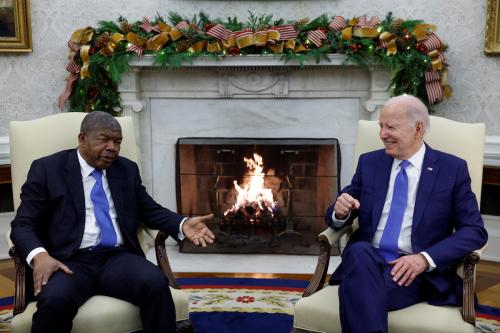On Wednesday, the State Department and the U.S. Agency for International Development unveiled the much-awaited Quadrennial Diplomacy and Development Review entitled “Leading Through Civilian Power.” The specific conclusions of the review are certainly of interest to many policymakers and policy watchers in Washington and around the world, but it is important to first recognize that the QDDR represents a critical effort to enhance strategic thinking and planning at both State and USAID. With an eye toward sharpened capabilities, one of the biggest tests of the review’s success will be whether it actually fosters an alignment of strategies and plans with appropriate resources.
Although the QDDR focuses on diplomacy and development, its readers should understand that the development issues covered constitute essential components of President Obama’s broader development policy across all the relevant instruments and agencies of the U.S. government, including but not limited to State and USAID. As Obama noted earlier this fall during his landmark development policy speech at the United Nations, “aid alone is not development,” and in addition to diplomacy, other policies like trade and investment are essential pieces of the puzzle.
Within the community focused on U.S. initiatives in diplomacy, foreign assistance, development, peace building and state building, there is a great deal of consensus on the need for strengthened civilian international affairs capacity. This consensus pre-dates the current review and the Obama administration, and it will be interesting to carefully examine the full QDDR, while reflecting on the recommendations from major study reports of the past decade. Many of these recommendations were parsed out in Surveying the Civilian Reform Landscape, a 2008 report I co-authored with Craig Cohen of the Center for Strategic and International Studies. In addition, a fair number of the most popular recommendations—whether on strategic planning, human resources and training, or engagement with the private sector—have a foothold in the QDDR.
From the QDDR executive summary, it is clear that the recommendations include many common-sense improvements necessary to execute effective diplomacy in the face of 21st century challenges. For example, the State Department will reorganize to focus on energy in close collaboration with economic and environmental affairs. It will also establish a coordinator for cyber issues, ensure better communications technology, continue to strengthen engagement with emerging powers, make its personnel systems more flexible to meet critical needs and take other steps to modernize.
One of the issues at the crux of the QDDR is how to deal with complex crises and conflicts. The focus is an important one, but a key recommendation for “a lead-agency approach with a clear division of leadership and responsibility” between State and USAID will not, in practice, have the clarity needed. State is assigned the lead for political and security crises and USAID has responsibility for leading responses to “humanitarian crises, resulting from large-scale natural or industrial disasters, famines, disease outbreaks and other natural phenomena.” However, famines are inherently political and the lines between these areas are murky enough that it may be bureaucratically difficult for USAID to truly lead on crises beyond the most tightly circumscribed delivery of disaster relief operations. Since USAID is the more operational agency, this leadership challenge may result in missed opportunities as State seeks to become more operational and more developmentally minded.
The most pressing issue with regard to U.S. peace building and state building efforts in fragile, conflict-affected regions is that of coordination across all relevant departments and agencies and this issue was largely beyond the scope of the QDDR. The Office of the Coordinator for Reconstruction and Stabilization at State has never been able to fulfill its whole-of-government coordination function, and its metamorphosis into a new Bureau for Crisis and Stabilization Operations will not help on this particular issue. What is needed is a much more robust coordination capacity at the White House.
On broader development issues beyond conflict and fragile states, the QDDR hits many of the right points. When USAID Administrator Rajiv Shah first took up his position a year ago, there were concerns that he was arriving too late to shape the review. The QDDR’s numerous delays and many of its conclusions related to development have shown that this concern was misplaced. The QDDR emphasizes systematic change over service delivery while placing high value on transparency, innovation, monitoring and evaluation, multi-year planning in close coordination with developing countries and rebuilding the core capacity of USAID. It has also determined that USAID should lead on the presidential initiatives related to food security and global health. This is a sound conclusion in accordance with President Obama’s policy of making USAID the government’s lead development agency and consciously begins to transition beyond the bureaucratically fragmented approach that has weakened U.S. global development efforts.
The QDDR’s decision to focus development support on specific sectors should lead many policy analysts to ask hard questions about how State and USAID define seemingly broad areas of concentration such as “sustainable economic growth.” Although greater focus is an important step toward more effective policies, everyone should also be asking what we will no longer be doing in order to achieve that goal.
Additionally, there is the question of geographic focus. How can we more deliberately concentrate our development efforts in particular countries? Where? And how might scaling back on bilateral assistance to certain countries relate to scaling up U.S. engagement with multilateral development institutions?
Other critically important questions relate to the interpretation of USAID mission directors as “primary development advisors” to U.S. ambassadors. How is this different from the past? Considering Obama’s stated intent for USAID to be the lead development agency, does this designation change USAID’s relationship with many other agencies of the U.S. government actively engaged in development support programs at the field level?
There is seemingly much to like about the QDDR, such as its well-placed focus on the role of women and girls in peace-building and development, but the review raises many questions. Ultimately, to make this type of review quadrennial in fact, rather than just in name, and to leave behind a legacy of institutional reform, the administration would do well to work closely with Congress. Secretary of State Hillary Clinton has boldly chosen to try to fundamentally change the culture of the State Department—a large project to say the least. With the full 200+ page QDDR now available, expect to witness a lively debate on whether this is possible and whether progress is being made.
Noam Unger, a Global Economy and Development Fellow and the Policy Director of the Brookings Institution’s Foreign Assistance Reform Project, has worked on humanitarian affairs, reconstruction, conflict transformation, and interagency coordination at both the Department of State and the U.S. Agency for International Development.
The Brookings Institution is committed to quality, independence, and impact.
We are supported by a diverse array of funders. In line with our values and policies, each Brookings publication represents the sole views of its author(s).



Commentary
Op-edThe QDDR: Following Through on Civilian Power?
December 16, 2010